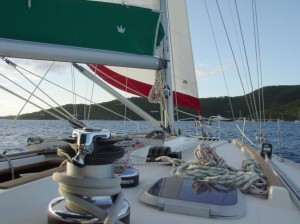The Transition to 48 Volt Equipment on Sailing Boats
The opportunity to migrate deck gear and equipment from 12 and 24 Volts up to 48 Volts is rapidly approaching as equipment manufacturers (OEM’s) attempt to address the problems associated with high electrical loads demanded from energy hungry equipment as well as the general increase in electrical energy consumption on sailboats.
The marine sector is not alone in this move as it is also occurring in the automotive sector (* see link below) as automotive OEM’s attempt to address the same problems of higher energy consumption in automobiles.
The move to 48 Volt from lower voltages will certainly have obvious advantages that include the reduction in electrical currents and associated increased life of electrical componentry and an overall reduction in weight (which is substantial).
However, the benefits of this transition to 48 Volts have a strategic aspect that lies beyond the obvious advantages of merely reducing electric current by increasing voltage.
There are several interesting technical developments occurring simultaneously in the 48 Volt market.
1) Leisure sailing boats in the less than 40 feet or so length class, with a propulsion power requirement of less than 20 kW (26hp) are adopting the increasingly popular 48 Volt propulsion systems for their boats.
These boats will have 48 Volt propulsion battery banks with capacities of say at least 30 kWh (or more) and will easily be capable of supporting the energy demands of sailing boat equipment and devices, including additional potential demands from the galley as LPG is removed completely from the boat in favour of new ultra-efficient, 48Volt electric options (keep an eye on this space for more information).
Whilst charging 48 Volt battery banks can still be achieved with solar, wind or shore power which will be sufficient for top up, particularly if on a mooring, but due to the increased energy density of new battery chemistries the requirement for these generation sources to charge will be reduced.
2) Most electric propulsion systems will include hydro-generation, which means that the 48 Volt propulsion battery is well situated to take on the addition energy support roles on the boat on longer sailing trips, and can also easily support a 12 Volt system. Hydro-generation provides for a much cleaner deck by potentially removing solar and wind generating equipment from sailing boats in active use or those berthed at marinas or up on the hard.
3) For larger sailing vessel with higher electric propulsion voltages, the move to 48 Volt equipment also offers substantial benefits including weight reduction in cabling, and removal of forward battery module (supporting winches, windlass and bow thruster), which is implemented as a solution to reduce the weight of long cable runs to the bow of the vessel.
4) The additional benefit for the marine sector from the 48 Volt developments may also contribute nicely to supporting short-handed sailing and relieve sail boat operators of some of the labour intensive tasks, providing more time to enjoy the water.
These new 48 Volt systems are likely to include some updated ‘smarts’ and like the automotive sector, this will provide an opportunity for equipment to be able to actuate and communicate over NMEA2K or CAN Bus networks.
It is these digital technologies that will emerge as the major contributors to solving the challenges associated with short-handed sailing and, like the automotive sector, will offer substantial advances in functionality and reliability as they start to be embedded into sailing boat systems.
* https://www.autoevolution.com/news/understanding-the-shift-to-48v-systems-happening-in-the-automotive-industry-150157.html
Tech Notes are a technical comment on a particular topic. Tech Notes are provided as guiding information only and are not to be relied upon as technical advice.
Please check our White Papers for more detailed information on this and related subjects.

